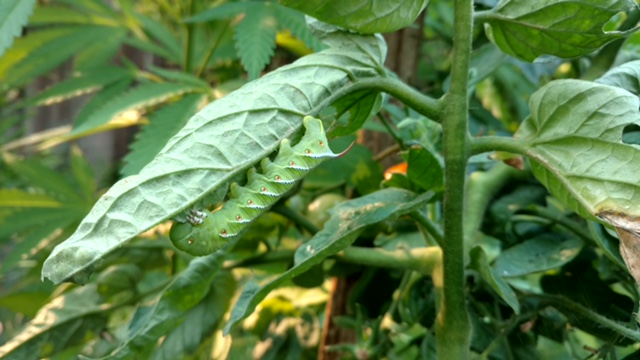
August heat brings out spike in population of these giant caterpillars

|
|
The tomato hornworm's coloring makes it hard to see among tomato leaves. Look
for its poop on leaves below or, at night, search using a UV flashlight. (Photo: Debbie Arrington)
|
They look like something out of a sci-fi movie – if you can spot them. And what they do to tomato plants is absolutely horrifying.
Recent hot, dry weather brought out a late-summer surge of one of the biggest bugs in our vegetable gardens: The tomato hornworm.
They love these last days of summer – and munching away on ripe tomatoes. While many critters retreat in high heat, these invaders actually spike in numbers and activity as the mercury rises.
Natural enemies usually keep their populations under control. But hornworm numbers tend to go up in August along with the temperature.
I saw this firsthand in my own Sacramento garden. I've picked off five hornworms from my tomato vines in five days.
Fat as a finger and just as long, hornworms rank as Sacramento’s largest caterpillars. They eat big bites out of their favorite food: Juicy tomatoes. They’ll also eat hard green tomatoes, leaves and stems.
Their stripes let them hide in plain sight. They blend in so well with their surroundings, they can seem impossible to spot.
What’s easy to see are leaves that have been stripped bare to the stem and damaged tomatoes. Other pests and critters may take bites out of tomatoes, but those stripped leaves – especially if the damage seems to appear overnight – usually indicate hornworms.
If you suspect hornworms, look for their poop. They leave large black or green droppings on or around the plant. If you see those droppings, carefully inspect the plant’s nearby leaves and stems. When you find it, pick off the hornworm and dispose of it. (Folks who raise chickens say their hens love them as a snack.)
If the hornworm escapes capture, it burrows into the soil and pupates into a moth of equally gigantic proportion: The hawk moth. Emerging in spring, this brown and gray moth has a 5-inch wingspan.
Rototilling the tomato bed after harvest prevents those moths from ever developing – and laying eggs next spring.
For more on tomato hornworms: http://ipm.ucanr.edu/PMG/GARDEN/VEGES/PESTS/hornworm.html
Comments
0 comments have been posted.Sacramento Digs Gardening to your inbox.
Food in My Back Yard Series
May 6: Maintain soil moisture with mulch for garden success
April 29: What's (already) wrong with my tomato plants?
April 22: Should you stock up on fertilizer? (Yes!)
April 15: Grow culinary herbs in containers
April 8: When to plant summer vegetables
April 1: Don't be fooled by these garden myths
March 25: Fertilizer tips: How to 'feed' your vegetables for healthy growth
March 18: Time to give vegetable seedlings some more space
March 11: Ways to win the fight against weeds
March 4: Potatoes from the garden
Feb. 25: Plant a fruit tree now -- for later
Feb. 18: How to squeeze more food into less space
Feb. 11: When to plant? Consider staggering your transplants
Feb. 4: Starting in seed starting
Sites We Like
Garden Checklist for week of May 4
Enjoy this spring weather – and get gardening!
* Plant, plant, plant! It’s prime planting season in the Sacramento area. Time to set out those tomato transplants along with peppers and eggplants. Pinch off any flowers on new transplants to make them concentrate on establishing roots instead of setting premature fruit.
* Direct-seed melons, cucumbers, summer squash, corn, radishes, pumpkins and annual herbs such as basil.
* Harvest cabbage, lettuce, peas and green onions.
* In the flower garden, direct-seed sunflowers, cosmos, salvia, zinnias, marigolds, celosia and asters. (You also can transplant seedlings for many of the same flowers.)
* Plant dahlia tubers. Other perennials to set out include verbena, coreopsis, coneflower and astilbe.
* Transplant petunias, marigolds and perennial flowers such as astilbe, columbine, coneflowers, coreopsis, dahlias, rudbeckia and verbena.
* Keep an eye out for slugs, snails, earwigs and aphids that want to dine on tender new growth.
* Feed summer bloomers with a balanced fertilizer.
* For continued bloom, cut off spent flowers on roses as well as other flowering plants.
* Add mulch to the garden to maintain moisture. Mulch also cuts down on weeds. But don’t let it mound around the stems or trunks of trees or shrubs. Leave about a 6-inch to 1-foot circle to avoid crown rot or other problems.